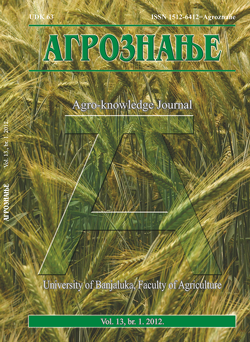Compariosn of three Chardonnay clones (Vitis vinifera L.), growing in Skopje'vineyard region, R.Macedonia
DOI:
https://doi.org/10.7251/AGREN1201095DAbstract
Some agro-biological and technological characteristics were determined for three Chardonnay clones selections, including 95, 124 and 277, cultivated in the Skopje vineyard region, the R. Macedonia (during the period from 2006 to 2008). A certificated seedling material was introduced from France in 1999/2000, cultivated and studied at the vineyards of the Department of Viticulture and Oenology, Institute of Agriculture, Skopje. The aim of the study was to apply optimal agro-technical and ampelotechnical measures and to compare characteristics of the three Chardonnay clones (95,124,277) cultivated in the same agro-ecological conditions. Different values of the examined characteristics were observed because of the selection specification as well as the ecological conditions during the period of the study. It was found that the yield was most stable for the clone 277 with a coefficient of variable 14.4, and the biggest variation of 21.7 was noticed for the 124 clone. Considering the chemical composition, more significant variation was observed for sugar content in the grape must from the clone 277, while insignificant variations were noticed for total acids in the must of all clones studied. The content of alcohol in the wines ranged from 12.88 vol% in the clone 277 to 13.95 vol% in the clone 95 for the examined period, thus insignificant variations were found in the three clones. Wines from all three clones for the vintage 2006 had greater contents of total extract and, for the examined period, wines with most extract for the clones 95 (21,30 g/L) and 277 (21,20 g/L). The wine made from the 277 clone was with the highest wine-tasting rating of 17.97 points.Downloads
Published
2012-12-18
Issue
Section
Articles

